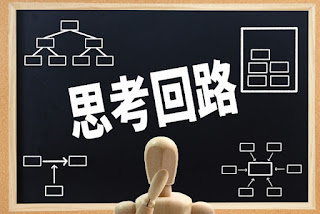〈37〉 ◆ chap 4 Advanced, how to construct a sentence !
part 4. “…kara”, “…node”,“…kedo(keredo)”
+ → + - → - , + → - - → +
In the last issue, we looked at how to join words together. In other words, we would have shown you how to simply join nouns, verbs and adjectives or arrange them according to the passage of time.
But language is also a tool for us to think about things. This means that, we need to combine these words according to our logic. So, in this issue, we will consider how to construct words logically in order to form sentences.
Now, let’s practice thinking in Japanese!
Below is the relationship between price and taste of food (Sushi and Ramen).
Common sense ←→ Anti-common sense ... and(kara,node)… ... but(kedo,keredo)…
—Sushi—
〈Price〉expensive, and tasty ←→ expensive, but not tasty
(kara,node) (kedo,keredo)
〜 Sushi wa takai kara oishii. Sushi wa takai kedo mazui(oishikunai).〜
—Ramen—
〈Price〉cheep, and not tasty ←→ cheep, but tasty
(kara,node) (kedo,keredo)
〜 Ramen wa yasui kara mazui(oishikunai). Ramen wa yasui kedo oishii.〜
 |
| Expensive and tasty? or Expensive but not tasty? |
In general, people think that expensive food is tasty and inexpensive food is not tasty. When judging things from such a common sense perspective, the Japanese words “kara…” and “node…” (In English “and”, “so”, “then”, “therefore”, etc.) are used to connect words.
Not only in terms of price and taste, but also in terms of the natural consequences, such as "it's hot and I'm sweating" or "I've worked hard, so I'm tired”, they say things like “…kara…, …node…”, when natural consequences seem to occur.
However, when, contrary to expectations or common sense, the food is expensive and tasteless, or cheap and tasty, we use the Japanese expression “…kedo…, …keredo…” (in English,“but”, “however”, etc.) to link things together. It is also often used to describe various unexpected things, such as "He is short, but he is good at basketball".
In other words, It means these words will be used.
(to connect + → +, - → -) , “…kara…” , “…node…”
(to connect + → -, - → +) , “…kedo…” , “…keredo…”
However, these words are used when sentences are joined together as below.
"ーーkara (so)、ーーdesu。”, "ーーkedo(but)、ーーdesu。”
(ーーから (so)、ーーです。) (ーーけど (but)、ーーです。)
Note that if they are separated and made into two sentences, the words used will change, as shown follows.
"ーーdesu。 dakaraーーdesu。" or, "ーーdesu。 demoーーdesu。”
(ーーです。 だからーーーです。 or, ーーです。 でもーーです。)
(or desukara, shitagatte) (or shikashi, keredomo)
(ですから, したがって) (しかし, けれども)
(= …. So... ) ( = …. But... )
 |
| “---, so---” ?, or “---, but---” ? |
◇
Did you notice that ? That's right! In English and other Western languages, sentences are normally joined in this way.
"ーー, so (then,therefore)ーー." or "ーーー, but (however)ーー."
However, the English "," (comma) is replaced by “.”(period) in Japanese “。”(maru) which ends the previous sentence and starts the next sentence with “dakara” or “demo”, like 「ーーです。だからーーです」「ーーです。でもーーです」, Right? But there is another way in Japanese.
If we force it into English,
(ーーーから(ので)、ーーーです), or (ーーーけど(けれど)、ーーーです)
"ーーーso (then,therefore),ーーー." or "ーーーbut (however),ーーー."
This leads to strange sentences like this. That's what conjunctions like “…kara ,node(so)" and “…kedo, keredo (but)" which were introduced at the beginning of this article. Haha, isn't Japanese a mysterious language ?
☆☆☆☆《Example sentences for this issue》 ☆☆☆☆
“ I practised a lot of Kanji today because I have a Japanese test tomorrow, but I couldn't remember them very well. So I'm going to get up early tomorrow morning and try again. But now my alarm clock is broken, so I'm not sure if I can really wake up.”
*
Try writing sentences like the one above by connecting verbs and adjectives as you wish. Your Japanese language skills will surely improve rapidly. Just one more step to go!
——————————————《reference answer》——————————————
“ashita wa nihongo no tesuto ga arukara, kyou wa takusan no kanji wo renshuu shitakedo, nakanaka oboeraremasendeshita. dakara ashita no asa hayaku okite mou ichido chousen suru tsumori desu. demo ima watashino mezamashi dokei wa kowareteirunode, hontouni okirarerukadouka shinpai desu.”
———————————————————————————————————————
Now, look forward to the next installment!
ーーー The next post will be
Part 4, “…noni”, “…nimokakawarazu”
https://vivasouy.whatisjapanese.com/2024/01/38-chap-4-advanced-how-to-construct.html
See you next time!
Welcome your comments and suggestions.
☆
I also have a Japanese internet class in Spanish, if time permits.
When you have any questions, why not give it a try? (30 € 2 H, 25 € 1.5 H, 20 € for less than 1H) Send me email → vivasouy1@mac.com Thak you !!
☆Copyright is not abandoned. You must contact the publisher to cite this sentence.



Comments
Post a Comment